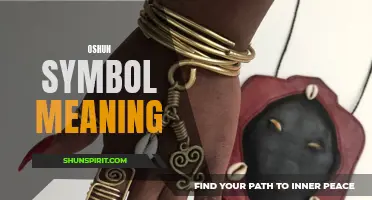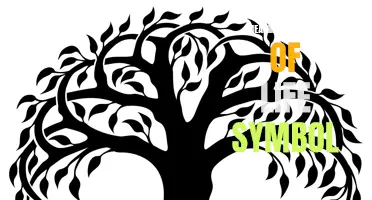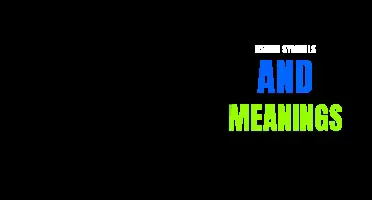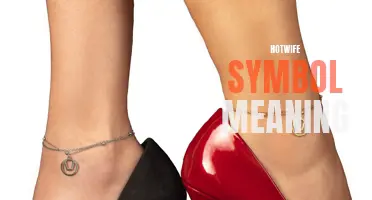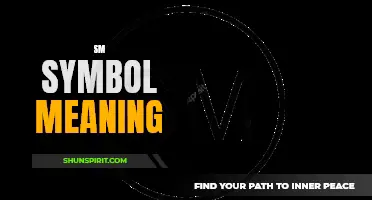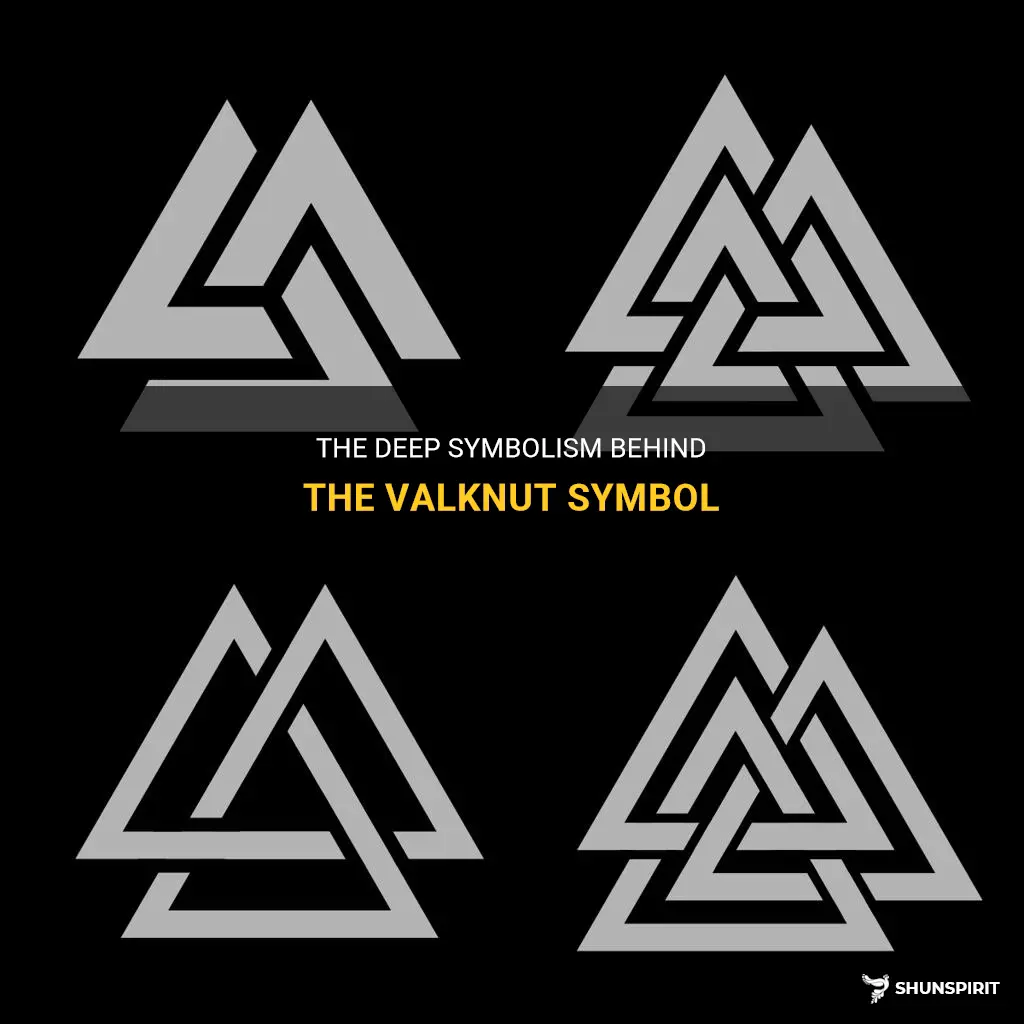
The Valknut symbol, also known as Odin's Knot or Hrungnir's Heart, is an intriguing ancient Norse symbol that has fascinated historians and enthusiasts for centuries. With its intricate interwoven triangles, this symbol carries a deep and profound meaning that reflects the complex beliefs and mythology of the Norse people. From its association with the god Odin to its connection with life, death, and the afterlife, the Valknut symbol continues to captivate and intrigue those seeking to unravel the mysteries of Norse culture. Join us as we delve into the depths of this symbol's meaning and unlock its secrets.
What You'll Learn
- What is the historical and cultural significance of the Valknut symbol?
- In what contexts is the Valknut symbol typically seen or used?
- How does the Valknut symbol differ from other Norse or Viking symbols?
- What are some common interpretations or theories about the meaning of the Valknut symbol?
- Are there any myths or legends associated with the Valknut symbol in Norse mythology?

What is the historical and cultural significance of the Valknut symbol?
The Valknut symbol, also known as the "knot of the slain" or the "Hrungnir's heart," is an ancient and powerful symbol that holds significant historical and cultural meaning. It is commonly associated with Norse mythology and has a rich history that spans back to the Viking Age.
The Valknut symbol consists of three interlocking triangles that form a knot-like shape. The exact meaning behind the symbol is not fully understood, as there are no direct references to it in the surviving Norse texts. However, it is believed to be associated with Odin, the chief god in Norse mythology, and to have connections with death, sacrifice, and the afterlife.
One theory suggests that the Valknut symbol represents the concept of the afterlife in Norse mythology. The three interlocking triangles are thought to symbolize the three realms of existence: Midgard (the realm of humans), Asgard (the realm of the gods), and Helheim (the realm of the dead). It is believed that warriors who died in battle would be chosen by Odin to join him in Valhalla, a great hall in Asgard where fallen warriors would spend eternity feasting and fighting in preparation for Ragnarok, the final battle.
Another possible interpretation of the Valknut symbol is that it represents the cycle of life, death, and rebirth. The interlocking triangles could symbolize the interconnectedness of these three stages and the endless cycle of existence. This interpretation aligns with the beliefs of the Norse people, who viewed life as a continuous process of transformation and saw death as a natural part of that process.
In addition to its association with death and the afterlife, the Valknut symbol is also believed to have been used as a protective talisman. It is often found on grave monuments and runestones, suggesting that it may have served as a symbol of protection for the deceased and their journey into the afterlife.
The significance of the Valknut symbol goes beyond its symbolism and ties to Norse mythology. It is also an important cultural artifact that reflects the beliefs and values of the Viking-Age Norse people. The symbol's presence in various archaeological sites and artifacts demonstrates the widespread use and cultural importance of this symbol during that time.
Today, the Valknut symbol is still recognized and embraced by modern-day practitioners of Asatru, a revivalist movement that seeks to reconnect with the traditions and beliefs of the ancient Norse people. The symbol has also gained popularity in popular culture, particularly in the realms of Norse-inspired art, tattoos, and jewelry.
In conclusion, the Valknut symbol holds great historical and cultural significance. While its exact meaning is still open to interpretation, it is widely associated with death, sacrifice, and the afterlife in Norse mythology. The symbol's use as a protective talisman and its presence in various archaeological sites demonstrates its importance to the Viking-Age Norse people. Today, it continues to be embraced by those seeking to honor and connect with Norse traditions and is a symbol that represents the rich and fascinating mythology of the Norse people.
Unlocking the Secrets: Unveiling the Hidden Meanings Behind Love Symbols
You may want to see also

In what contexts is the Valknut symbol typically seen or used?
The Valknut symbol, also known as the "knot of the slain" or the "knot of the slain warriors," is a powerful Norse symbol that is often associated with the god Odin and his role as the god of war and death. It consists of three interlocking triangles that are sometimes interpreted as representing the three realms of existence: life, death, and the afterlife.
In Norse mythology, Odin was often depicted as a god who made sacrifices and sought knowledge and wisdom. The Valknut symbol is believed to represent Odin's power to bind and unbind the fates of warriors on the battlefield. It is often associated with Odin's role as a chooser of the slain, as he would select warriors who had died honorably in battle to join him in Valhalla, the hall of the slain.
The Valknut symbol is predominantly seen in Viking-age artifacts and artwork, such as rune stones, carvings, and jewelry. It is often found in association with depictions of warriors, battle scenes, and funeral rituals. The symbol is believed to have been used to honor fallen warriors and as a symbol of protection for those engaged in combat.
In addition to its association with Odin and Norse mythology, the Valknut symbol has also been used in modern Scandinavian cultures as a symbol of cultural heritage and pride. It is often incorporated into contemporary artwork, tattoos, and jewelry, serving as a reminder of the rich history and traditions of the Norse people.
Moreover, the Valknut symbol has also gained popularity in various forms of popular culture, such as books, movies, and video games, where it is often associated with themes of strength, courage, and warrior ethos. Its distinctive design and connection to Norse mythology make it a visually striking and intriguing symbol that captures the imagination of many.
However, it is important to recognize that the Valknut symbol has been appropriated by some extremist groups and individuals who espouse racist ideologies. This unfortunate association has led to the symbol being misinterpreted and misunderstood by some. It is important to approach the symbol with an understanding of its historical context and the values it represents in Norse mythology.
In conclusion, the Valknut symbol is a powerful and significant symbol in Norse mythology, representing Odin's role as a chooser of the slain and his power over life, death, and the afterlife. It is predominantly seen in Viking-age artifacts and artwork, as well as modern Scandinavian cultures, where it serves as a symbol of cultural heritage and pride. Additionally, the symbol has gained popularity in popular culture, although it is important to be aware of its misappropriation by extremist groups.
The Deep and Symbolic Meaning Behind Rammstein's Iconic Symbol
You may want to see also

How does the Valknut symbol differ from other Norse or Viking symbols?
The Valknut symbol is one of the most recognizable symbols associated with Norse or Viking mythology. It is often depicted as three interlocking triangles, forming a triangle with a central void. While it is similar to other Norse or Viking symbols, there are a few key differences that set it apart.
One of the main differences between the Valknut symbol and other Norse or Viking symbols is its unique shape. The three interlocking triangles create a complex and intriguing pattern that is instantly recognizable. This shape is not commonly found in other symbols associated with Norse or Viking mythology, making the Valknut symbol stand out.
Another difference is the meaning and interpretation of the Valknut symbol. While other symbols may represent specific gods, goddesses, or concepts, the Valknut symbol is believed to have a broader meaning. It is often associated with death, sacrifice, and the afterlife. Some interpretations suggest that the Valknut symbol may represent the interconnection of the three realms in Norse mythology - Asgard (the realm of the gods), Midgard (the realm of humans), and Helheim (the realm of the dead).
Additionally, the Valknut symbol is commonly associated with Odin, the Allfather and king of the Norse gods. Odin is often depicted with the Valknut symbol, which further emphasizes its connection to him. Other symbols, such as Mjölnir (Thor's hammer) or the Aegishjalmur (Helm of Awe), are associated with specific gods or goddesses, while the Valknut symbol is more closely tied to Odin and his domain.
Despite these differences, the Valknut symbol shares some similarities with other Norse or Viking symbols. For example, many symbols in Norse or Viking culture feature interconnected patterns, representing the interplay of the natural world and the divine. Both the Valknut symbol and other Norse or Viking symbols often embody themes of strength, courage, and spirituality.
In conclusion, the Valknut symbol differs from other Norse or Viking symbols in its unique shape, broader meaning, and association with Odin. While it shares some similarities with other symbols in Norse or Viking mythology, these differences make the Valknut symbol a distinctive and important symbol in its own right.
Exploring the Fascinating Symbolism of the Black Diamond
You may want to see also

What are some common interpretations or theories about the meaning of the Valknut symbol?
The Valknut symbol is an ancient Norse symbol consisting of three interlocking triangles. It is often associated with the god Odin and is believed to have deep spiritual and mythological significance. There are several interpretations and theories about the meaning of the Valknut symbol, ranging from its connection to the afterlife to its representation of the cycle of life and death.
One interpretation suggests that the Valknut symbol represents Odin's power over life and death. In Norse mythology, Odin is known as the Allfather and is associated with wisdom, magic, and war. As the ruler of the gods, Odin has the ability to decide who lives and who dies. The three interlocking triangles of the Valknut symbol are said to represent the interconnectedness of life, death, and the afterlife.
Another theory suggests that the Valknut symbol represents the concept of reincarnation. The three triangles can be seen as representing the cycle of life, death, and rebirth. This interpretation aligns with the Norse belief in the existence of multiple realms or worlds, such as Midgard (the world of humans), Asgard (the world of the gods), and Helheim (the realm of the dead). The Valknut symbol may symbolize the journey of the soul through these different realms.
Some scholars propose that the Valknut symbol is associated with warrior symbolism. The three triangles could represent the three stages of a warrior's life: initiation, battle, and death. The symbol may have been used to invoke Odin's protection and guidance in battle, or to honor fallen warriors.
Another interpretation links the Valknut symbol to the concept of fate and destiny. In Norse mythology, Fate, represented by the Norns, controls the destinies of humans and gods alike. The Valknut symbol may represent the interconnectedness of fate, weaving the threads of life and death.
While these interpretations provide some insight into the meaning of the Valknut symbol, it is important to note that the symbol's original significance may never be fully understood. Norse mythology and beliefs were passed down through oral tradition, and much of the original meanings and symbolism may have been lost over time.
Regardless of its exact meaning, the Valknut symbol continues to be a powerful and enduring symbol in Norse culture. It is often used today in modern Viking and pagan communities as a symbol of strength, protection, and connection to ancient Norse heritage.
The Symbolic Meaning of the Wolf: Unveiling its Deep Significance
You may want to see also

Are there any myths or legends associated with the Valknut symbol in Norse mythology?
The Valknut symbol is an enigmatic and fascinating emblem in Norse mythology. Comprised of three interlocking triangles, it is also known as the "Knot of the Slain" or the "Hrungnir's Heart." While there is limited direct mention of the Valknut in the ancient Norse sagas, it has acquired several interpretations and associations through the centuries, often shrouded in myth and legend. Let's explore some of the myths and legends surrounding this mysterious symbol.
One prevalent myth suggests that the Valknut represents the interconnection between life, death, and destiny. The three triangles symbolize different realms: the present, the past, and the future. This interpretation is based on the belief that the Norse gods controlled the destinies of mortals and that the Valknut was a visual representation of their influence.
According to Norse mythology, the valkyries, Odin's chosen female warriors, would decide the fate of soldiers on the battlefield, selecting the worthy to be taken to Valhalla, the afterlife hall of the slain. Some speculate that the Valknut might have been used by the valkyries to mark their chosen ones. The intertwined triangles could have served as a sign for fallen warriors to guide them on their journey to the afterlife.
Another intriguing legend associates the Valknut with Odin himself, the Allfather of the Norse pantheon. Odin was known for his wisdom, shamanic practices, and connection to death. It is said that Odin would use the power of the Valknut to bind the souls of the fallen warriors, ensuring their loyalty and service in the afterlife. This legend further reinforces the symbolic link between the Valknut, death, and Odin's role as the god of war and wisdom.
There is also a theory that the Valknut could be linked to the concept of reincarnation. In Norse mythology, souls were believed to be reincarnated, and the Valknut could have represented the cyclic nature of life and death. The intertwined triangles might symbolize the continuous journey of the soul, intertwining in a never-ending cycle.
Although myths and legends have offered various interpretations of the Valknut symbol, it is important to note that the exact meaning and significance of this emblem remain uncertain. The Valknut is predominantly found on ancient Norse artifacts, such as runestones and burial stones. These artifacts offer glimpses into the beliefs and practices of the Norse people, but they do not provide definitive explanations for the Valknut's purpose.
Nevertheless, the enduring allure of the Valknut symbol persists to this day. It continues to capture the imagination of those intrigued by Norse mythology and ancient symbolism. Whether associated with the valkyries, Odin, or the cycle of life and death, the Valknut remains a powerful and enigmatic emblem that embodies the mysteries of Norse mythology.
The Symbolic Meaning Behind Thor's Hammer: Exploring the Power and Protection of Mjölnir
You may want to see also
Frequently asked questions
The Valknut symbol, also known as the "knot of the slain," is an ancient Norse symbol that represents the connection between life and death. It is often associated with the Norse god Odin and is believed to symbolize his power and authority over life and death.
Yes, the Valknut symbol is closely associated with Viking mythology. It is often found on ancient Viking artifacts and is believed to have been used as a symbol of protection and strength in battle. It is sometimes referred to as the "Hrungnir's heart" in reference to a mythical giant from Norse mythology.
The Valknut symbol is made up of three interlocking triangles, which are sometimes referred to as "knotwork" or "knot patterns." These triangles are often interpreted as representing the interconnectedness of the realms of existence - the past, present, and future. They can also be seen as symbolizing the three aspects of Odin: the creator, the preserver, and the destroyer.
Yes, the Valknut symbol is often associated with death and the afterlife in Norse mythology. It is believed to symbolize Odin's role as the god of death and his ability to guide the souls of the fallen warriors to the afterlife. The symbol is sometimes used in modern times as a representation of honoring and remembering those who have passed away.


